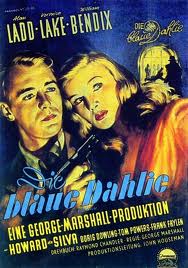 The Blue Dahlia/1946/Paramount/96 min.
The Blue Dahlia/1946/Paramount/96 min.
Sitting here waiting for the Tigers game to start and for the bf to make dinner, I keep thinking of food metaphors. For instance: watching “The Blue Dahlia” is like ordering a blue-cheese burger at a steakhouse – tasty fare, but not quite as satisfying as filet mignon. So I have a one-track mind. I’m hungry.
That does, however, sum up “The Blue Dahlia” – it’s a pretty good yarn and in the hands of a more stylish director, instead of comedy specialist George Marshall, it might have been a true gem. In Marshall’s hands, the visuals are ho-hum, there’s not much atmosphere and there are several moments where the pace seems to idle. Overall, it feels a bit dated.
On the plus side, Veronica Lake and Alan Ladd lead a strong cast and Raymond Chandler received an Oscar nom for his original screenplay. (It lost to the British psychological drama “The Seventh Veil” by Muriel and Sydney Box.) Also, “The Blue Dahlia” has several famous location shots, such as the Brown Derby, and in 1947 the film’s title gave rise to the name of one of Hollywood’s most nefarious real-life mysteries.
Ladd plays an ex-Navy bomber pilot named Johnny Morrison, who arrives in Los Angeles with two pals from the Navy. The three jump off the bus at Hollywood Boulevard and head to the nearest bar. Buzz (William Bendix) has sustained war injuries (he has a plate in his skull) and isn’t thinking too clearly; his foil is calm and level-headed George (Hugh Beaumont, aka Ward Cleaver on “Leave it to Beaver.”)
Next up for Johnny is a reunion with his wife Helen (Doris Dowling) at her bungalow apartment on Wilshire Boulevard. Not exactly a picture of wifely devotion, raven-haired, rye-chugging Helen is hosting a raucous party that night. (Doris Dowling’s real-life older sister Constance Dowling played shady lady Mavis Marlowe in the film noir “Black Angel,” also from 1946, based on a Cornell Woolrich novel and directed by Roy William Neill.)
After Helen confesses that her drinking led to the death of their son, Johnny pulls his gun out and considers using it, but changes his mind. Instead he drops the gun on an armchair, next to a blue dahlia flower from Helen’s, um, companion, slick and sleazy Eddie Harwood (Howard Da Silva). Harwood owns the Blue Dahlia nightclub, hence he hands out flowers.
Johnny heads out into the rainy night and hitches a ride with Joyce Harwood (Lake), a chilly blonde goddess with an air of mystery. She’s also Eddie Harwood’s estranged wife.
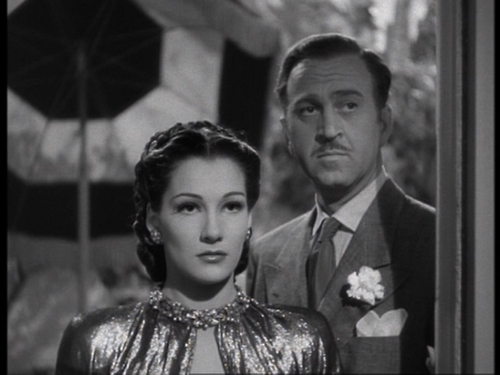
Helen (Doris Dowling) would rather drink a beer than win Mother of the Year. Her chum Eddie (Howard Da Silva) owns the Blue Dahlia nightclub.
Well, as you know, no good deed goes unpunished in film noir and leaving the gun behind wasn’t the wisest decision on Johnny’s part. The next morning Helen is dead and Johnny tops the list of suspects. Others on the list include disloyal Eddie Harwood, the oft-confused and easily excited Buzz, who paid Helen a visit the night of her death, and ‘Dad’ Newell (Will Wright), the seedy house detective at Helen’s apartment complex.
In Chandler’s original script, Buzz did the deed but painting a vet in bad light would be courting disaster with the censors so Chandler had to revamp the story and find a new villain. Reportedly, Chandler, who was fond of drinking like a fish, locked himself away one weekend and got even more smashed than usual in order to cobble together the revised script, which the studio needed in a hurry because Ladd was called for military service.
A highlight of the flick is the wry banter between Ladd and Lake – this was the third of four films they made together (preceded by “This Gun for Hire” and “The Glass Key,” and followed by 1948’s “Saigon”) and by this time they have it down. Ladd snarls and pushes her away, Lake purrs and turns her nose up, aloof and amused.
“The Blue Dahlia” also played a part in the aftermath of Hollywood’s most famous unsolved murder: Elizabeth Short, a pretty girl from a Boston suburb who came to Hollywood looking for adventure or a husband, whichever came first. Short was brutally killed; her mutilated body was found on Jan. 15, 1947.
As the police investigation progressed, Short became widely known as the Black Dahlia. Some say a Long Beach bartender dubbed her the Black Dahlia in 1946 because of her sometimes-theatrical appearance (acquaintances said she liked wearing heavy makeup and flowers in her hair when she dressed up); others attribute the moniker to journalists covering the grisly case. Either way, “The Blue Dahlia” movie triggered the nickname.
“The Blue Dahlia,” with its smart writing and solid acting, is required film noir viewing, despite its flaws. And I almost forgot – there’s a great dry moment when the maid finds Helen’s body. No screaming or wringing of hands for this hard-living broad, just an “Oh brother” and a long sigh.
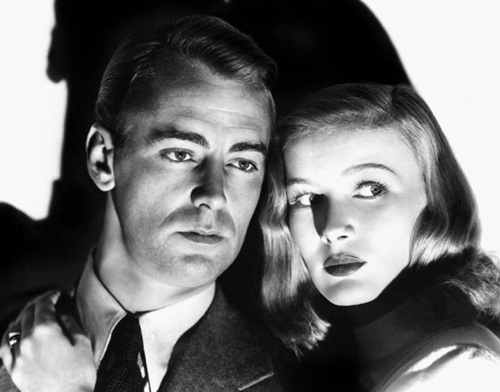
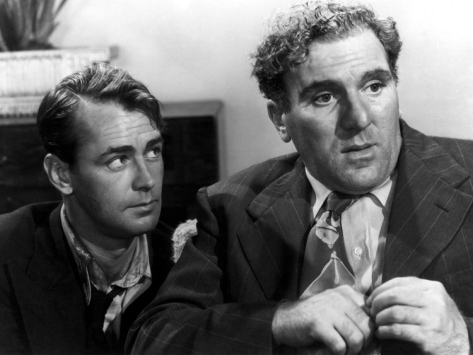
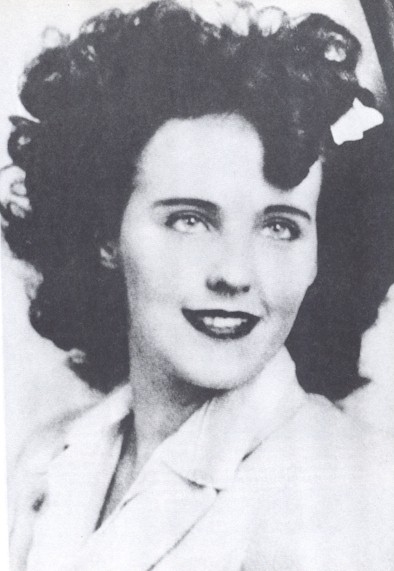










From FNB readers